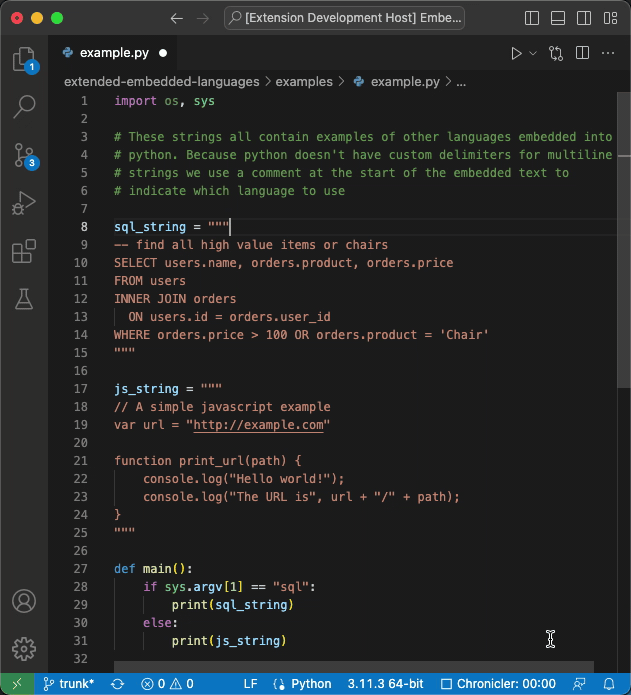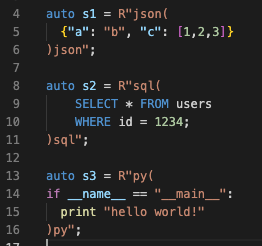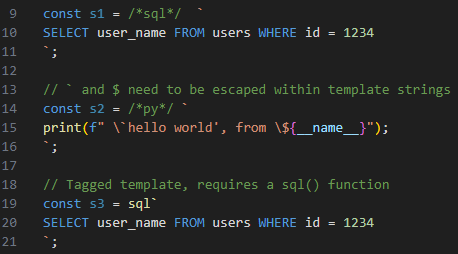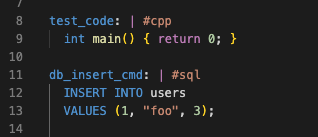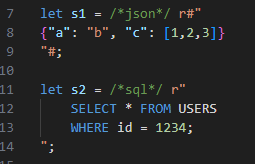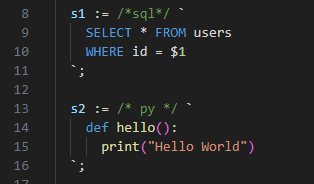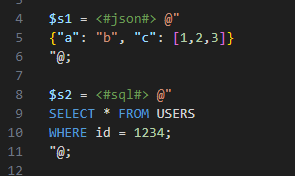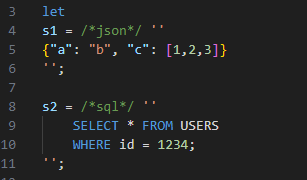Adds syntax highlighting to C++, Go, Javascript, TypeScript, Python, Rust, PowerShell, YAML and Nix for strings containing source code. Dozens of languages can be used within the strings such as markup languages (HTML, LaTeX), query languages (SQL, GraphQL), data languages (JSON, YAML), shader languages (GLSL, WSGL), scripts (Shell, Bat) and many more.
This Visual Studio Code extension enables syntax highlighting within strings that contain source code. For example, a Python script might have strings containing SQL or HTML or Bash. This plugin will add syntax highlighting, and additionally code folding and language-specific editor features within those strings.
This is similar to how you can select syntax highlighting within
Markdown documents using a language specifier (e.g. ```py) or
switch between HTML, Javascript, and CSS in the same HTML document.
This plugin extends the syntax highlighting of several host languages in order to highlight embedded sub-languages within strings.
You need to specify which language you are using within the string.
How this is done depends on the host language (see below). Once that
is done you can see and edit the embedded language just like you are
editing a standalone file using that language. For example if you are
editing SQL within a C++ document, the VSCode "Toggle Line Comment"
command will prefix lines with -- not //. Code folding will use
the natural structure of the embedded language block too - collapsing
<tags> in an XML string, or { braces in a C string
C++ uses raw strings to specify the language.
A raw string in C++ looks like
auto s = R"foo( ...text )foo";Between the " and ( an arbitrary token can be placed which we use
here to specify the language. This token needs to exist at the end of
the string as well:
Javascript and TypeScript template strings delimited by backticks
(e.g. `...text...`) can be multiline. This extension supports
two different ways to specify the language in a multiline template
string.
As an inline comment before the beginning of the string:
const s = /*lang_id*/ `
code goes here
`;Or as a tagged template, this style expects there to be a function with the name of the language which can process the string (see the tagged template documentation for examples and for an identity template which just returns the input string)
const s = lang_id`
code goes here
`;Python multiline strings do not have custom terminators the way C++,
Perl or other languages do. As such, we rely on leading comments to
identify a language. This comment must be immediately after the '''
or """ which starts a multiline string
YAML has block strings that begin with a | or > and continue based
on the indentation level of a block of text. Following the start
indicator you can put a comment (this is a YAML comment) which
indicates the language
Rust strings are all multiline. But for syntax embedding purposes we
use the multiline raw strings that begin with r#" (where there are
0-n # characters) and end with "#
All Go strings are multi-line, but this extension uses raw strings for code blocks. These are strings that are surrounded by backticks and can contain quote and backslash characters without the need for escaping them (they can not, however, easily contain backticks). These strings must be prefixed with an inline comment indicating the language ID
In Powershell you can use here-strings for the code blocks. (e.g. `@"...text..."@`, but it can be multi-line). To specify the
language, you use a inline comment before the string:
Nix multiline strings are delimited by ''(e.g. ''...text...'').
To specify the language, you use a inline comment before the string:
This extension supports a large number of embedded languages, listed below. The "ID" column shows the IDs you can use in host languages like C++ and YAML where you can specify an ID in the host language. The "Comment" column is for host languages like Python which have no way to indicate the embedded language type directly, and shows what the first characters of the embedded language string needs to be to signal which language you are using.
| Name | ID | Comment |
|---|---|---|
| ARM assembly | arm | @arm,;arm |
| Batch | bat | REM, @REM, ::bat |
| C | c | /*c*/ |
| C++ | cpp, c++ | //cpp, //c++ |
| CSS | css | /*css*/ |
| GLSL | glsl | //glsl |
| GraphQL | graphql, gql | #graphql, #gql |
| Graphviz | graphviz, dot | //graphviz, //dot |
| Handlebars | handlebars, hbs | //handlebars, //hbs |
| HLSL | hlsl | //hlsl |
| HTML | html | <!DOCTYPE, <html, <!--html |
| Ini | ini | ;ini |
| Javascript | js, javascript | //js |
| JSON | json | 1 |
| JSONC | jsonc | //jsonc |
| LaTeX | latex | %latex |
| Lua | lua | --lua |
| Makefile | makefile, make | #make, #makefile, #!/usr/bin/make |
| Markdown | markdown, md | <!--md |
| Metal shading language | metal | //metal |
| Python | py, python | #py |
| Powershell | powershell, ps1 | #powershell |
| Shell | sh, bash, shell, shellscript | #sh, #bash, #shell, #!/bin/sh, ... |
| SQL | sql | --sql |
| TeX | text | %tex |
| TOML | toml | #toml |
| TypeScript | typescript, ts | //typescript, //ts |
| WGSL | wgsl | //wgsl |
| x86 and x64 assembly | x64, x86_64, x64 | ;x86, ;x86_64, ;x64 |
| XML | xml | <?xml, <? xml, <!--xml |
| YAML | yaml | #yaml |
See CONTRIBUTING.md for adding new languages
-
Syntax highlighting can leak past the end of the string when there are unclosed blocks (for example a
{without a matching}). This is a limitation of the TextMate grammars that VSCode uses - when an embedded syntax highlighter scans for the end of a text section it can scan past the end of the string. VSCode issue 20488 has a longer discussion on what is going on. -
Because of this same issue, some languages can't be embedded due to how they are defined. For example the most popular
csvandmermaidhighlighters will continue past the end of the string when they are embedded.
See CHANGELOG.md for full list of changes
Footnotes
-
JSON does not support comments, so there is no way to indicate a string is a JSON document within the string. ↩
